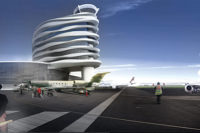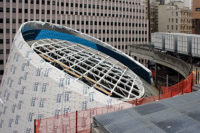
The use of a curved steel frame double-wall system to achieve a spiritual aesthetic shines the spotlight on the Interfaith Peace Chapel. Demonstrating tremendous creativity and technical finesse, the on-site team of Dallas-based Lasco Drywall & Acoustics captured the spirit of the architect’s posthumous design with arresting accuracy.
Renowned architect Philip Johnson’s contribution to the Interfaith Peace Chapel, located on the campus of the Cathedral of Hope, United Church of Christ in Dallas, was a lifetime in the making. Johnson finalized the design for the chapel just before his death in 2005. Five years later, in the fall of 2010, the building was completed and Johnson’s epic career concluded with the designer’s most personal project to date. There are no right angles or parallel lines in the frame of the chapel and the deep sweeping curves of the doorways evoke a sense of openness and pliancy within the congregation.

TWIN WALLS
To accommodate the design of the continuously curving thick walls, Radius Track fabricated a custom dual framing system. Two “twin structures” were created for the inside and outside walls, using 3⅝-inch 33-mil studs and track for the interior walls and 6-inch 54-mil studs and track for the exterior walls. The company’s CEO and Chief Design Officer Chuck Mears, AIA, say a way to maximize the inner/outer wall connection to add strength. He designed an extended clip system that connected both walls to the steel structure, using only a single horizontal clip, instead of using two different clips.
Jeremy Williams at Lasco, the drywall contractors on the project, says that the project went very well due to the level of detail provided by the manufacturer.
“We were given X/Y/Z dimensions for some curved ceilings to build off of, and to show the architect and owner that the ceilings could be installed exactly as shown on their design,” Williams says. “Radius Track provided field use drawings that showed where every track and stud piece, which were individually numbered, went. For such a complicated project, it went extremely well.”
Key Players:
Philip Johnson/Alan Ritchie Architects, Design Architects
Cunningham Architects, Gary Cunningham FAIA, Tom Dohearty, AIA and Rizi Faruqui, AIA, Architects of Record
Radius Track Corporation
Structure Tone Southwest, General Contractors
THHinc (Trabue, Hansen & Hinshaw, Inc.), Consulting Engineers
Thornton Tomasetti, Structural Engineers of Record
Irwin Steel, Structural Steel Fabricator
Lasco Acoustics and Drywall, Inc., Drywall Contractor
Gypsum Supply Ltd., Drywall Distributor
Materials:
Cold formed steel, interior and exterior 3-D modeling. Signed and sealed engineered calculations. 6-inch 16 gauge exterior studs and track. 3⅝-inch 20 gauge interior studs and track. (Radius Track supplied)
Drywall and plaster (Lasco supplied)








